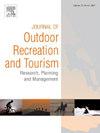Examining the relationship between leisure constraints and quality of life: A case of hikers in Ningbo, China
IF 4.4
3区 管理学
Q1 HOSPITALITY, LEISURE, SPORT & TOURISM
Journal of Outdoor Recreation and Tourism-Research Planning and Management
Pub Date : 2025-01-07
DOI:10.1016/j.jort.2024.100854
引用次数: 0
Abstract
The impact of leisure on quality of life (QOL) has garnered increasing scholarly attention from the public health perspective. However, as a key concept within leisure studies, leisure constraint's impact on QOL remained unstudied, especially from the perspective of hiking in non-Western developed countries. Although past qualitative studies indicated that leisure constraints might lead to poorer QOL, empirical evidence is lacking. Thus, to fill in this research gap, we collected 606 useable questionnaires from hikers on the North Hills' Trail in Ningbo, Zhejiang province, China. We empirically examined the relationship between leisure constraint, plus hiker's demographic variables and QOL. The results revealed that: (1) Intrapersonal constraint significantly predicted physical health; Environmental and facilities constraint significantly predicted environmental health; Interpersonal constraint significantly predicted all QOL dimensions (e.g., psychological health, environmental health, social relationship health, and physical health); Accessibility constraint significantly predicted psychological health; Time constraint significantly predicted social relationships health; (2) Among demographic variables, income significantly predicted psychological health, environmental health, social relationships health, and physical health. Both age and number of children are significant predictors of physical health. We offered new insight into hikers' constraint factors from the perspective of non-Western developed countries, provided empirical evidence to fill the research gap about leisure constraint and QOL, and further enriched existing research about leisure, QOL and hiking.
休闲约束与生活质量的关系研究:以宁波徒步旅行者为例
从公共卫生的角度来看,休闲对生活质量(QOL)的影响已经引起了越来越多的学术关注。然而,作为休闲研究中的一个关键概念,休闲约束对生活质量的影响尚未得到研究,特别是从非西方发达国家徒步旅行的角度来看。虽然过去的定性研究表明休闲约束可能导致较差的生活质量,但缺乏经验证据。因此,为了填补这一研究空白,我们从中国浙江省宁波市北山步道的徒步旅行者中收集了606份可用的问卷。实证研究了休闲约束、人口统计变量与生活质量之间的关系。结果表明:(1)内省约束对身体健康有显著的预测作用;环境和设施约束显著预测环境健康;人际约束对生活质量各维度(如心理健康、环境健康、社会关系健康和身体健康)均有显著预测作用;可及性约束显著预测心理健康;时间约束显著预测社会关系健康;(2)在人口统计变量中,收入对心理健康、环境健康、社会关系健康和身体健康有显著的预测作用。年龄和子女数量都是身体健康的重要预测指标。本文从非西方发达国家视角对徒步旅行者的约束因素进行了新的认识,为填补休闲约束与生活质量的研究空白提供了经验证据,进一步丰富了现有的关于休闲、生活质量与徒步旅行的研究。
本文章由计算机程序翻译,如有差异,请以英文原文为准。
求助全文
约1分钟内获得全文
求助全文
来源期刊

Journal of Outdoor Recreation and Tourism-Research Planning and Management
HOSPITALITY, LEISURE, SPORT & TOURISM-
CiteScore
6.70
自引率
5.30%
发文量
84
期刊介绍:
Journal of Outdoor Recreation and Tourism offers a dedicated outlet for research relevant to social sciences and natural resources. The journal publishes peer reviewed original research on all aspects of outdoor recreation planning and management, covering the entire spectrum of settings from wilderness to urban outdoor recreation opportunities. It also focuses on new products and findings in nature based tourism and park management. JORT is an interdisciplinary and transdisciplinary journal, articles may focus on any aspect of theory, method, or concept of outdoor recreation research, planning or management, and interdisciplinary work is especially welcome, and may be of a theoretical and/or a case study nature. Depending on the topic of investigation, articles may be positioned within one academic discipline, or draw from several disciplines in an integrative manner, with overarching relevance to social sciences and natural resources. JORT is international in scope and attracts scholars from all reaches of the world to facilitate the exchange of ideas. As such, the journal enhances understanding of scientific knowledge, empirical results, and practitioners'' needs. Therefore in JORT each article is accompanied by an executive summary, written by the editors or authors, highlighting the planning and management relevant aspects of the article.
 求助内容:
求助内容: 应助结果提醒方式:
应助结果提醒方式:


